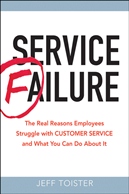The customer service disconnect
 Jeff Toister
Jeff Toister  Tuesday, March 8, 2011 at 2:03PM |
Tuesday, March 8, 2011 at 2:03PM | There are three kinds of lies: lies, damned lies, and statistics.
- Mark Twain
The first time I saw that quote was in an angry email from the President of the small catalog company I had started working for three weeks prior. They were starting to grow and had hired me to help them improve training and employee performance. The company President took exception to a report I wrote that predicted the average order size would go down since the new catalog targeted a wider customer base with a slew of high volume, low priced items.
This turned out to be a tipping point for the company. The average order size did go down, but there were soon other signs that the President (and majority owner) was disconnected from his customers. He remained doggedly loyal to old suppliers even as quality and delivery problems led to mounting customer complaints. The company launched a new line of products that consumed precious resources without coming anywhere near the success of the original catalog. The company started losing loyal customers, ran into cash flow problems, and went out of business for good a few years later.
Unfortunately, this head in the sand approach to customers isn’t uncommon. A 2006 Bain & Company study found that 80% of companies surveyed felt they delivered superior customer service but the customers of only 8% of those companies agreed. It makes you wonder what the management teams at the other companies were thinking.
This disconnect isn’t confined to senior management. I have run a small experiment many times with companies and have received very consistent results. I ask a room full of customer service reps to rate the customer service they personally deliver on a scale of 1 – 5 with 5 being best. Next, I ask the reps to look around the room and assign a rating to the entire team. On average, the reps rate themselves a 4 while rating the team a 3. The math doesn’t add up but it does show that most of the reps believed they were better than their peers even without any objective basis for reaching this conclusion.
Possible Explanations
There are a range of explanations for this disconnect. It might be the company culture, the individual's ego, or perhaps a natural tendancy to ignore blind spots. Please leave a comment if you have an idea about the underlying causes. Better yet, how do companies solve it?








